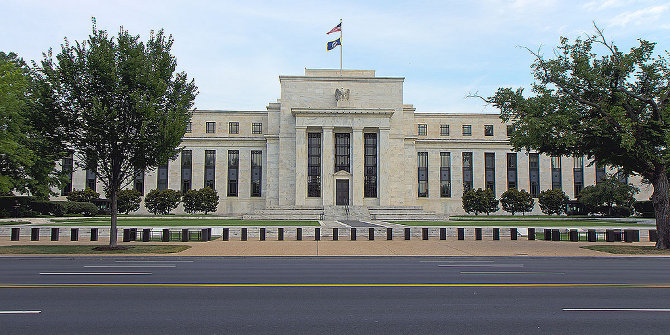 Last week, the US Federal Reserve announced that it would increase its Fund Rate by 0.25 percent – the first such increase in nine years. Eddie Gerba writes that under normal economic conditions such an interest rate rise would help savers, lead to more balanced investments, and help firm productivity. But, he points out, conditions post-Great Recession are far from normal. Lower levels of corporate productivity and higher interest rates may mean fewer firms survive, and the financial sector may no longer be able to lead economic recovery due to uncertainty about regulation and the sector’s future.
Last week, the US Federal Reserve announced that it would increase its Fund Rate by 0.25 percent – the first such increase in nine years. Eddie Gerba writes that under normal economic conditions such an interest rate rise would help savers, lead to more balanced investments, and help firm productivity. But, he points out, conditions post-Great Recession are far from normal. Lower levels of corporate productivity and higher interest rates may mean fewer firms survive, and the financial sector may no longer be able to lead economic recovery due to uncertainty about regulation and the sector’s future.
After almost a decade of uncharted territory in modern monetary policy including measures such as the zero-lower-bound (ZLB) of the nominal interest rate, three waves of quantitative easing and an ‘operation twist’, the Fed’s chairwoman Janet L. Yellen finally announced last week that the Federal Reserve will proceed with a rise of 0.25 percent in the US benchmark rate, the Fed’s Fund Rate. Economists around the world can at last breathe out as this (symbolically) marks the end of an era of turbulence, high risks, and unconventional measures. The immediate market reaction was also one of relief. Many investors have anxiously anticipated this move over the past year, and now at last their expectations have been fulfilled.
Under traditional circumstances, the effects would be predictable. For US corporates, this would be a perfect opportunity to increase the total productivity of firms and remove the so-called ‘zombie companies’, or firms that are only sustained because of the low borrowing rate environment. At the same time, a gradual increase in borrowing rates would function as a profitability filter as banks would only give loans to firms they judge profitable in the medium-run. Hence, short-termism in the corporate lending market would be limited. For consumers, a rise in rates would be good news for savers, as they would receive a higher return on their deposits. Moreover, under a low-inflation environment, real interest rates will be high which would incentivize prudent consumption behavior over time and dis-incentivize overspending. For traditional investors, this would result in a more balanced investment strategy and after a while, the end of desperate return seeking in riskier segments of the market. At the same time, additional liquidity would be released as safe-havens such as gold and other precious metals lose their shine as the interest rate climbs. On the foreign exchange market, a rise in the US interest rate would, everything else equal, result in an influx of liquidity into the US and an appreciation of the US dollar. Investors can borrow cheaply in Europe or Japan and buy high-yielding bonds in the US. For emerging markets, the rise would be perceived as a relief as this would end the so-called ‘currency attacks’ that their currencies have experienced since the onset of unconventional measures.

But there are several indicators suggesting we are not under traditional circumstances. The recovery from the Great Recession is still far from over. Despite the loose borrowing conditions, US consumers have spent less than they otherwise have following other crises in the past. Now that the rate has increased, there is a high chance that they will spend even less. Productivity in the corporate sector remains very low. Some economists fear that this low productivity environment will remain well into the medium- (or even the long-) run due to demographic and technological shifts. Tighter borrowing conditions in such setting might result in even lower survival rate for firms (including those which have been productive up to now) due to more costly external financing, lower revenues and lower cash ratios.
But most importantly, the US financial sector is far from the joyful days of the ‘Great Moderation’. The level of financial intermediation is significantly lower, financial engineering has slowed down and there is still a high level of uncertainty regarding the new regulatory landscape as well as the future of the entire sector. Moreover taking into account that this sector has become the motor of the American economy since the late 1990’s, a failure to revive it might be costly in the longer-term. On the international front, a lot of questions remain regarding the (possible) recovery in the Euro Area and Japan. And more recently, the slowing growth rate in the BRICS region is generating uncertainty regarding their capacity to balance the slow and stagnating performance of the advanced economies. In an environment like this, it is not so clear whether a rising interest rate will manage to re-allocate enough capital to fertile industries and provide the right impetus to the financial sector such that the US recovery can really take off.
But there are also costs of inaction. Therefore, the decision of whether to raise interest rates, such as in the US, or to allow them to fall further, as in the Euro Area, is basically conditional on the answers to the following questions:
What is the optimal monetary policy under uncertainty?
How do central banks make decisions when the exact macroeconomic risks are unknown?
Should their policies focus on longer-term growth or short-run cyclical recovery when the future path of the economy is highly uncertain?
Please read our comments policy before commenting.
Note: This article gives the views of the author, and not the position of USAPP– American Politics and Policy, nor of the London School of Economics.
Shortened URL for this post: http://bit.ly/1Zp0iOB
_________________________________
About the author
 Eddie Gerba – LSE European Institute
Eddie Gerba – LSE European Institute
Eddie Gerba is a Research Fellow at the London School of Economics and holds degrees from Pompeu Fabra, ETH Zurich, LSE, and University of Kent. Eddie’s research interests lie in the fields of macroeconomics and quantitative finance. Of particular interest to his research are financial frictions, liquidity cycles, monetary policy, financial intermediation theory, as well as risk management and macroeconomic stability. Method-wise, his interests and experience lie in DSGE-models, computational methods, time-series econometrics, and derivative pricing models.






